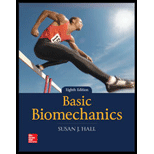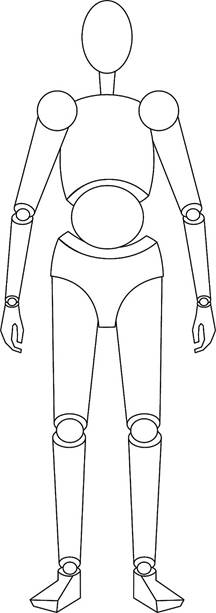
Concept explainers
If you had to design a model of the human body composed entirely of regular geometric solids, which solid shapes would you choose? Using a straightedge, sketch a model of the human body that incorporates the solid shapes you have selected.
To explain: The model of human body with different solid shapes.
Concept introduction: In general, human body is made of segments in irregular shapes and diverse mass distributions. Human body is made of bone, muscles, and fat that have different densities and distributed unevenly in individuals.
Explanation of Solution
Some investigators modeled the human body using different geometric solids. This helps an individuals to calculate the moment of inertia for regularly shaped solid substances. Fig.1 represent the model of human body that incorporates the solid shapes using s straightedge.

Fig.1: Model of human body using different solid shapes.
The solid shapes that are used to construct the model of human body are given below:
- Head is elliptical in shape.
- The neck region is slender cylindrical in shape.
- Scapula and clavicle are joined together in circle shaped articulating bones.
- Trunk part of the human body is cylinder in shape.
- The abdomen region is spherical in shape.
- Humerus, ulna, radius, femur, tibia, and fibula bones on the hands and legs are cylindrical in shape.
- The pelvic region of the human model is in cone shape.
- Elbows, tendons, and joints are spherical in shape.
- Feet resemble pentahedron shape.
Want to see more full solutions like this?
Chapter 14 Solutions
BASIC BIOMECHANICS
- Match the four different structure levels to their descriptionarrow_forwardIf you were a pharmaceutical researcher, why would you want to learn the three-dimensional shapes of naturally occurring molecules?arrow_forwardUsing the terms of position and direction, illustrate the various planes of the body. Your illustration should include the following terms: Cranial, Caudal, Ventral, Dorsal, Sagittal plane, Median section, Transverse section, Lateral and Frontal (coronal section).arrow_forward
- Can you give and describe specific examples how basic units of structure define the function of living things?arrow_forwardWhat picture does it correspond to?arrow_forwardWhen using word components to relate medical terms to the structure and function of the human body, why is it important to be able to break down medical terms into component parts? Why not just memorize each term? What is the point of learning all these Latin terms, anyway? Aren't they just an outmoded tradition?arrow_forward
- Can any one help me with this ? I am making notes on diagrams. I want someone to describe given figure in details with step by step manner. please make two step First step- short descriptions Second step- long descriptionsarrow_forwardidentify its structurearrow_forwardCan body composition be directly measured? Why or why not?arrow_forward

